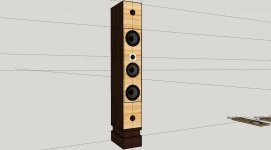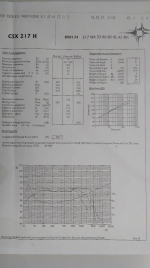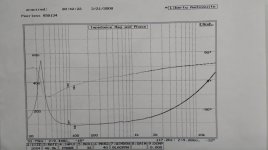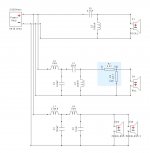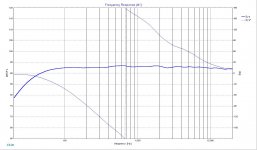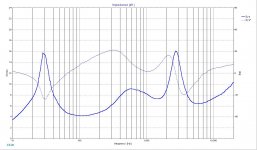Hi everyone!
I am planning of building a 3way design with a Focal tweeter, PHL Midwoofer and 2 Peerless woofers I have at home.
Focal is 6ohms
PHL 16ohms
Peerless 8ohms (each) - 4 ohms in paralell
It will probably be a bi-amp system. Separate Mid/High and Lows.
My question is;
- How unfriendly actually is a 16ohm midwoofer for crossover design and amplifier matching.
Should I choose a more suitable mid for this system? Should I get a different midrange? 8ohms?
Thank you all : )
I am planning of building a 3way design with a Focal tweeter, PHL Midwoofer and 2 Peerless woofers I have at home.
Focal is 6ohms
PHL 16ohms
Peerless 8ohms (each) - 4 ohms in paralell
It will probably be a bi-amp system. Separate Mid/High and Lows.
My question is;
- How unfriendly actually is a 16ohm midwoofer for crossover design and amplifier matching.
Should I choose a more suitable mid for this system? Should I get a different midrange? 8ohms?
Thank you all : )
Normally 16 ohms should not be a problem. It will rely slightly more on the amplifier Voltage swing than current delivery. This is not necessarily something you would notice, and it's not something you should.
Your crossover values would be slightly different than if it were 8 ohms, again no problem.
Your crossover values would be slightly different than if it were 8 ohms, again no problem.
The downside of 16 ohm drivers is that any associated passive crossover requires larger inductors, which are usually a bit more expensive.
the important thing is that the sensitivities of the drivers will work together. What are the model numbers?
the important thing is that the sensitivities of the drivers will work together. What are the model numbers?
The increase in resistance is an advantage. Where the wire diameter can be 0.7 and with 1.4 times the number of turns, the amount of copper should be the same.which are usually a bit more expensive.
Normally 16 ohms should not be a problem. It will rely slightly more on the amplifier Voltage swing than current delivery. This is not necessarily something you would notice, and it's not something you should.
Your crossover values would be slightly different than if it were 8 ohms, again no problem.
Great to know! I was worried I could actually have a sonic difference by driving a 16ohms speaker into a 8ohms amp. I am planning of buying a Bryston 4BST soon, and want to know if I am ok with it. I need stable amplifing...
The downside of 16 ohm drivers is that any associated passive crossover requires larger inductors, which are usually a bit more expensive.
the important thing is that the sensitivities of the drivers will work together. What are the model numbers?
I am using
- Focal TC90 TD5B 91.5db sens (x2)
- PHL 2011 B201-16 (puchased at Orca Design about 15 years ago) 94db sens (x2)
- Peerless 850134 88db sens (x4)
My idea is to built a WTMW Design. I already have someone working on the woofers Enclosure design. They will be ready this saturday.
It´s mainly going to be used in a Recording Studio. I am really tired of spending lots of money on cheep sounding studio monitors. If it is not ATC or PMC it´s not worth it. That´s why a couple of years ago I buildied my own with this PHL Woofers (actually someone else did it) But I just realised they are 16ohms! I like the sound though, a little bit midrangy, but very reveling at the same time.
I´ll attach some documents! Some help and tips are more than welcome!
: )
Well if you're going active then you might as well go three way, and remove all the confusion that passive components throw in there, especially if you're main hobby isn't filter design.
But I can see why you want to use that PHL, that's amazingly sensitive. It's the Focal that's going to be the laggard here, but it is the TC90, so not exactly awful, you have a potent set of drivers there.
But I can see why you want to use that PHL, that's amazingly sensitive. It's the Focal that's going to be the laggard here, but it is the TC90, so not exactly awful, you have a potent set of drivers there.
Last edited:
Well if you're going active then you might as well go three way, and remove all the confusion that passive components throw in there, especially if you're main hobby isn't filter design.
But I can see why you want to use that PHL, that's amazingly sensitive. It's the Focal that's going to be the laggard here, but it is the TC90, so not exactly awful, you have a potent set of drivers there.
I thought about it. But It demands spending around 2k in a good active crossover.
I rather have a passive xover as I need the chain to be as transparent as possible. It will be used in a recording studio as main monitors. We already have some dynaudio nearfield monitors as another option...
Talking about xovers. Using Xsim. Is there any chance of adding another amp in the system? It would be so much easier to emulate the system I want to use. Bi Amp Lows & Mid-Hi´s.
If not, I am always troubleshooting with Lows Impedance messing up my mid-hi :/
Last edited:
Here are some simulations I have been doing!
I like the RTA response. Don`t pay attention to the L-Pad on the Peerless. I just added to have a better view of the final RTA Response. It will be controlled by my monitor controller with a separate Stereo Output specially calibrated for it.
I am having troube with the impedance curve though. What do you guys think?
Cheersss!
I like the RTA response. Don`t pay attention to the L-Pad on the Peerless. I just added to have a better view of the final RTA Response. It will be controlled by my monitor controller with a separate Stereo Output specially calibrated for it.
I am having troube with the impedance curve though. What do you guys think?
Cheersss!
Attachments
-
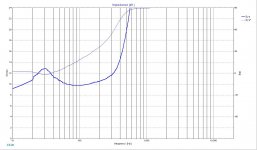 Z RESPONSE TOTEM LOW.jpg105.2 KB · Views: 49
Z RESPONSE TOTEM LOW.jpg105.2 KB · Views: 49 -
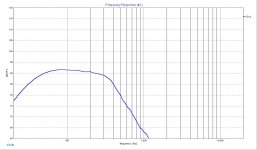 FREQ RESPONSE TOTEM LOW.jpg94.2 KB · Views: 62
FREQ RESPONSE TOTEM LOW.jpg94.2 KB · Views: 62 -
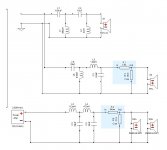 XOVER DESIGN TOTEM LOW.jpg46.2 KB · Views: 51
XOVER DESIGN TOTEM LOW.jpg46.2 KB · Views: 51 -
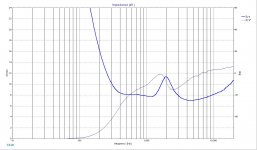 Z RESPONSE TOTEM MID HI.jpg108 KB · Views: 57
Z RESPONSE TOTEM MID HI.jpg108 KB · Views: 57 -
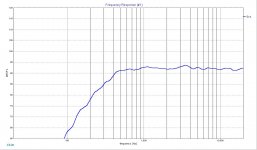 FREQ RESPONSE TOTEM MID HI.jpg95.6 KB · Views: 58
FREQ RESPONSE TOTEM MID HI.jpg95.6 KB · Views: 58 -
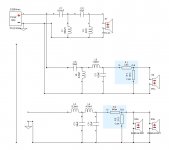 XOVER DESIGN TOTEM MID-HI.jpg46.1 KB · Views: 53
XOVER DESIGN TOTEM MID-HI.jpg46.1 KB · Views: 53 -
 Z RESPONSE TOTEM V4.jpg109.5 KB · Views: 63
Z RESPONSE TOTEM V4.jpg109.5 KB · Views: 63 -
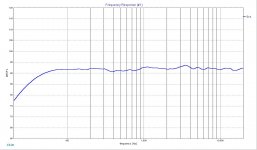 FREQ RESPONSE TOTEM V4.jpg95.8 KB · Views: 122
FREQ RESPONSE TOTEM V4.jpg95.8 KB · Views: 122 -
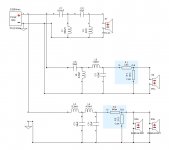 XOVER DESIGN TOTEM V4.jpg46 KB · Views: 128
XOVER DESIGN TOTEM V4.jpg46 KB · Views: 128
You seem to be making progress.
I'm not sure your system wouldn't prefer a downward tilt toward the treble. What don't you like about the impedance?
I'm not sure your system wouldn't prefer a downward tilt toward the treble. What don't you like about the impedance?
You seem to be making progress.
I'm not sure your system wouldn't prefer a downward tilt toward the treble. What don't you like about the impedance?
Hi Allen!
Thanks for that!
I saw the graph a little untidy respect to frequency. But I guess that not a big issue... Anyways, I have been studying the design this past week and got to this result (attached)...
I think I´ll go for a first prototype this next week. Hope it works well!
Any suggestions?
btw. I know what ESR means in a capacitor, but XSim gives you the chance to change this value. Which affects heavily on the design. Does anyone knows what standard value should I use?
Thank you all! 🙂
Attachments
I would worry more if there weren't any impedance variations in specific locations, or if there were variations where they shouldn't be. You seem to be within tolerance at the moment.
Have you considered that a box will not keep things consistent for you? Baffle simulation might give a minimum of information that you should consider.
Have you considered that a box will not keep things consistent for you? Baffle simulation might give a minimum of information that you should consider.
I had! I am troubleshooting a "Run-time error '1004':" message that Unibox gives me all the time...
couldn´t get it to work...
couldn´t get it to work...
- Home
- Loudspeakers
- Multi-Way
- 16ohm Midwoofer in a 3way design
